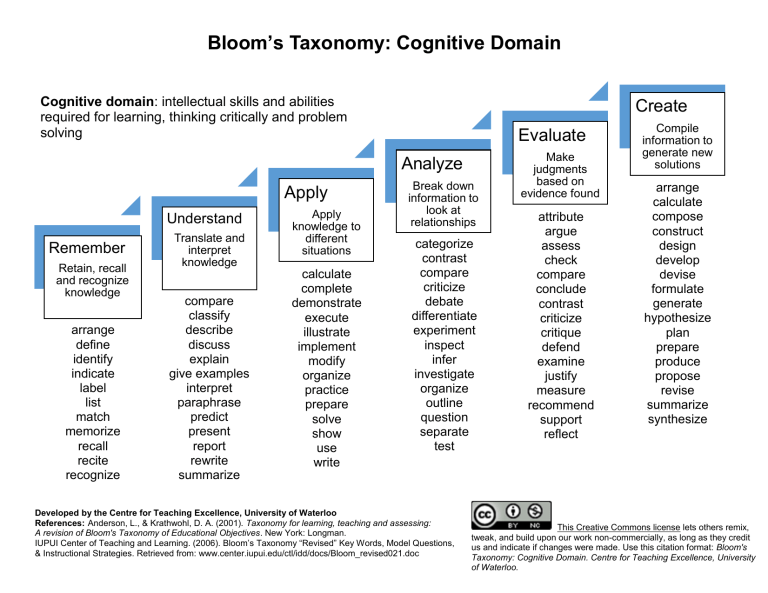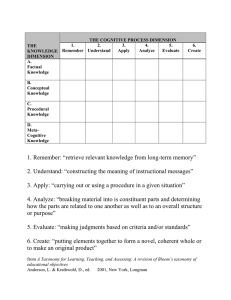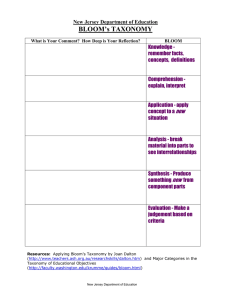
Bloom’s Taxonomy: Cognitive Domain Cognitive domain: intellectual skills and abilities required for learning, thinking critically and problem solving Create Evaluate Analyze Apply Understand Remember Retain, recall and recognize knowledge arrange define identify indicate label list match memorize recall recite recognize Translate and interpret knowledge compare classify describe discuss explain give examples interpret paraphrase predict present report rewrite summarize Apply knowledge to different situations calculate complete demonstrate execute illustrate implement modify organize practice prepare solve show use write Break down information to look at relationships categorize contrast compare criticize debate differentiate experiment inspect infer investigate organize outline question separate test Developed by the Centre for Teaching Excellence, University of Waterloo References: Anderson, L., & Krathwohl, D. A. (2001). Taxonomy for learning, teaching and assessing: A revision of Bloom's Taxonomy of Educational Objectives. New York: Longman. IUPUI Center of Teaching and Learning. (2006). Bloom’s Taxonomy “Revised” Key Words, Model Questions, & Instructional Strategies. Retrieved from: www.center.iupui.edu/ctl/idd/docs/Bloom_revised021.doc Make judgments based on evidence found attribute argue assess check compare conclude contrast criticize critique defend examine justify measure recommend support reflect Compile information to generate new solutions arrange calculate compose construct design develop devise formulate generate hypothesize plan prepare produce propose revise summarize synthesize This Creative Commons license lets others remix, tweak, and build upon our work non-commercially, as long as they credit us and indicate if changes were made. Use this citation format: Bloom's Taxonomy: Cognitive Domain. Centre for Teaching Excellence, University of Waterloo. Remember Learning Activities Flashcards Highlight key words List Memory activities Reading materials Watching presentations and videos Understand Case studies Concept map Demonstrations Diagrams Flowcharts Group discussions Mind map Matrix activity Play/sketches Summarize Think-pair-share Apply Clicker questions Fill in the blanks Label Match Multiple choice Quizzes True and false questions Concept map Create a summary Essay Diagrams Infographics Matrix activity One-minute paper Presentation Provide examples Quizzes Short answers Calculate Case studies Concept map Creating examples Demonstrations Flipped classroom Gallery walk Gamification Group work Lab experiments Map Problemsolving tasks Short answers Role play Discussion board post E-portfolio Lab reports One-minute paper Presentation Problemsolving tasks Short answers Analyze Evaluate Case studies Compare and contrast (with charts, tables, Venn diagrams) Concept map Debates Discussions Flowchart Graph Group investigation Mind map Questionnaires Report/survey Think-pairshare Analysis paper Case study Evaluation criteria Critique hypothesis, procedures etc. Muddiest point One-minute paper Research paper Review paper Developed by the Centre for Teaching Excellence, University of Waterloo References: Anderson, L., & Krathwohl, D. A. (2001). Taxonomy for learning, teaching and assessing: A revision of Bloom's Taxonomy of Educational Objectives. New York: Longman. IUPUI Center of Teaching and Learning. (2006). Bloom’s Taxonomy “Revised” Key Words, Model Questions, & Instructional Strategies. Retrieved from: www.center.iupui.edu/ctl/idd/docs/Bloom_revised021.doc Debates Compare and contrast (with charts, tables, Venn diagrams) Concept map Journal Pros and cons list Mind map Review paper Create Argumentative or persuasive essay Debates Discussions Presentation Provide alternative solutions Report Brainstorm Decision-making tasks Develop and describe new solutions or plans Design project Performances Presentations Research projects Written assignment Develop criteria to evaluate product or solution Grant proposal Outline alternative solutions Research proposal This Creative Commons license lets others remix, tweak, and build upon our work non-commercially, as long as they credit us and indicate if changes were made. Use this citation format: Bloom's Taxonomy: Cognitive Domain. Centre for Teaching Excellence, University of Waterloo.


